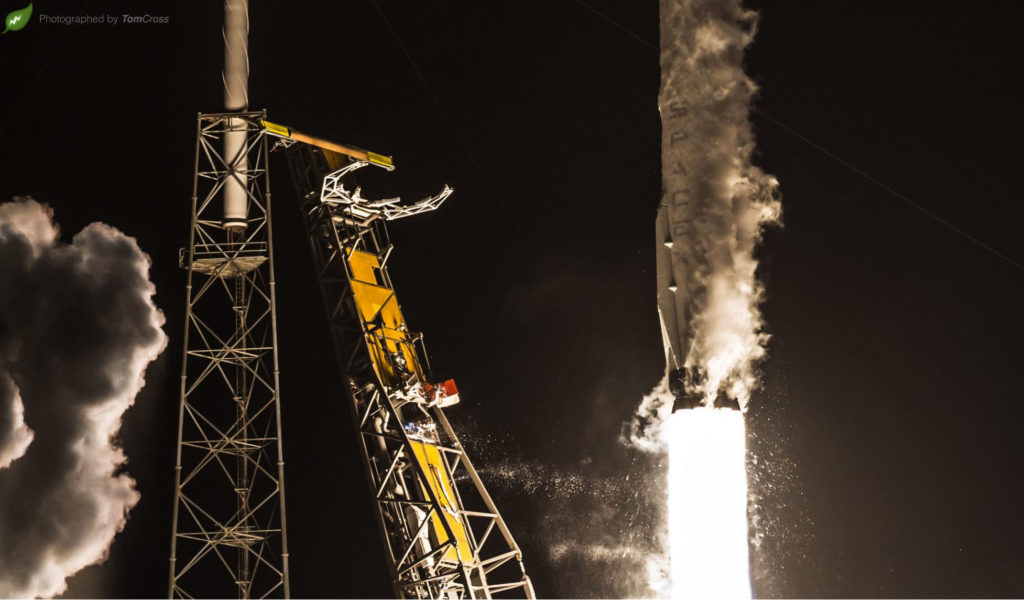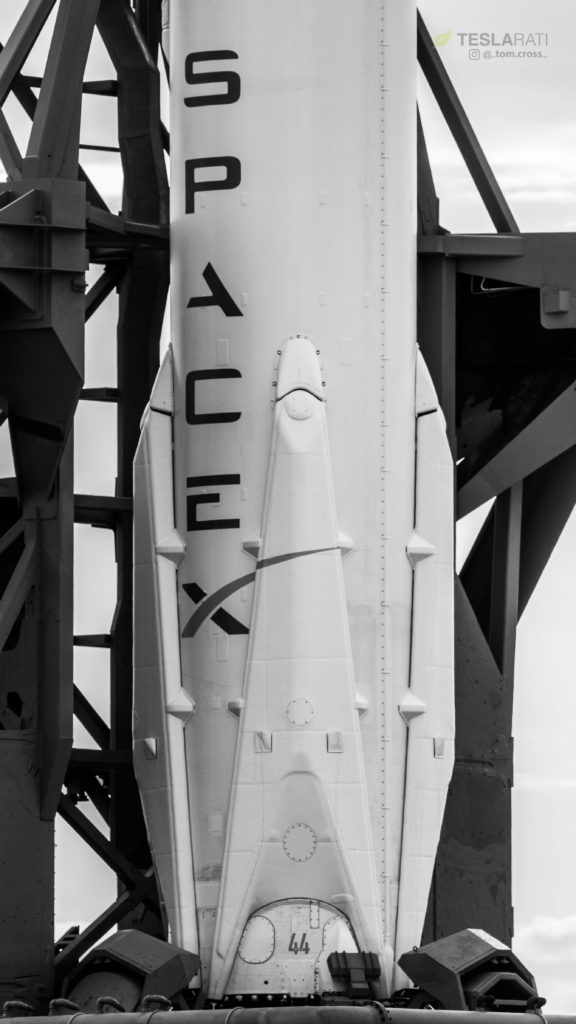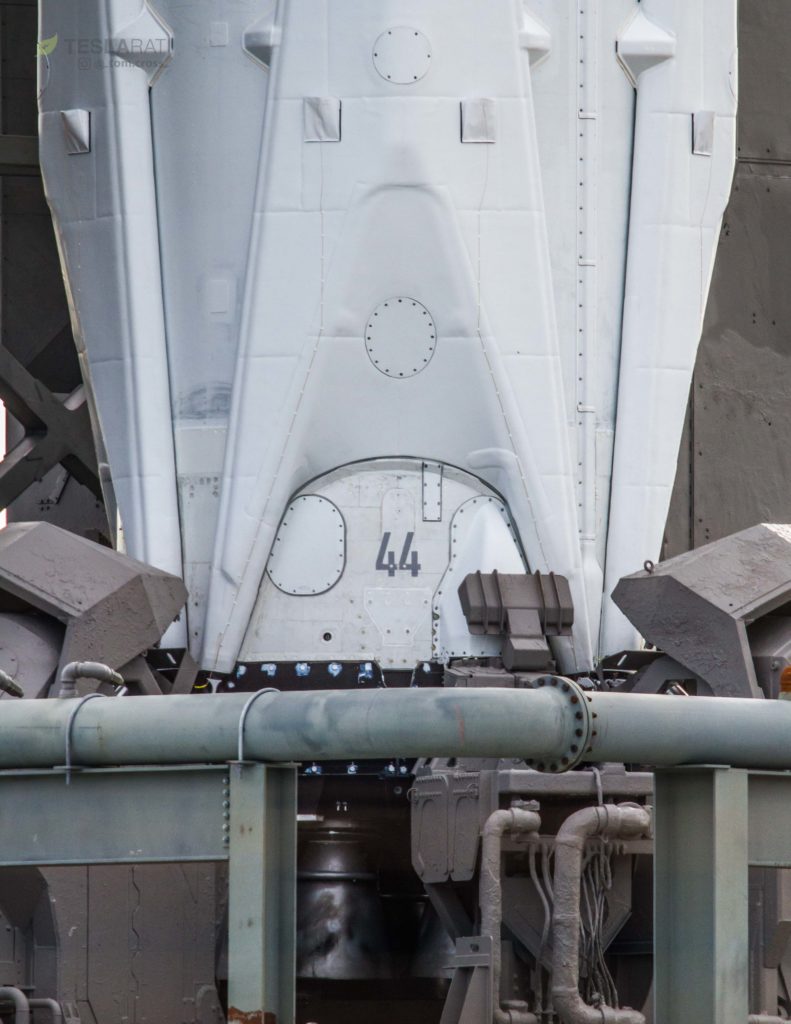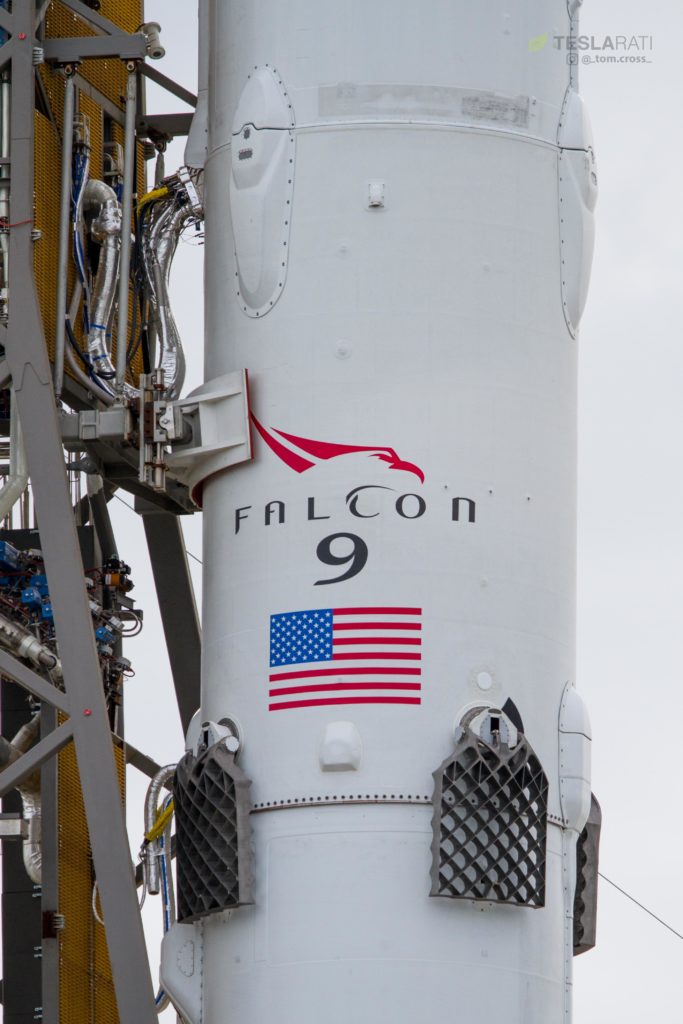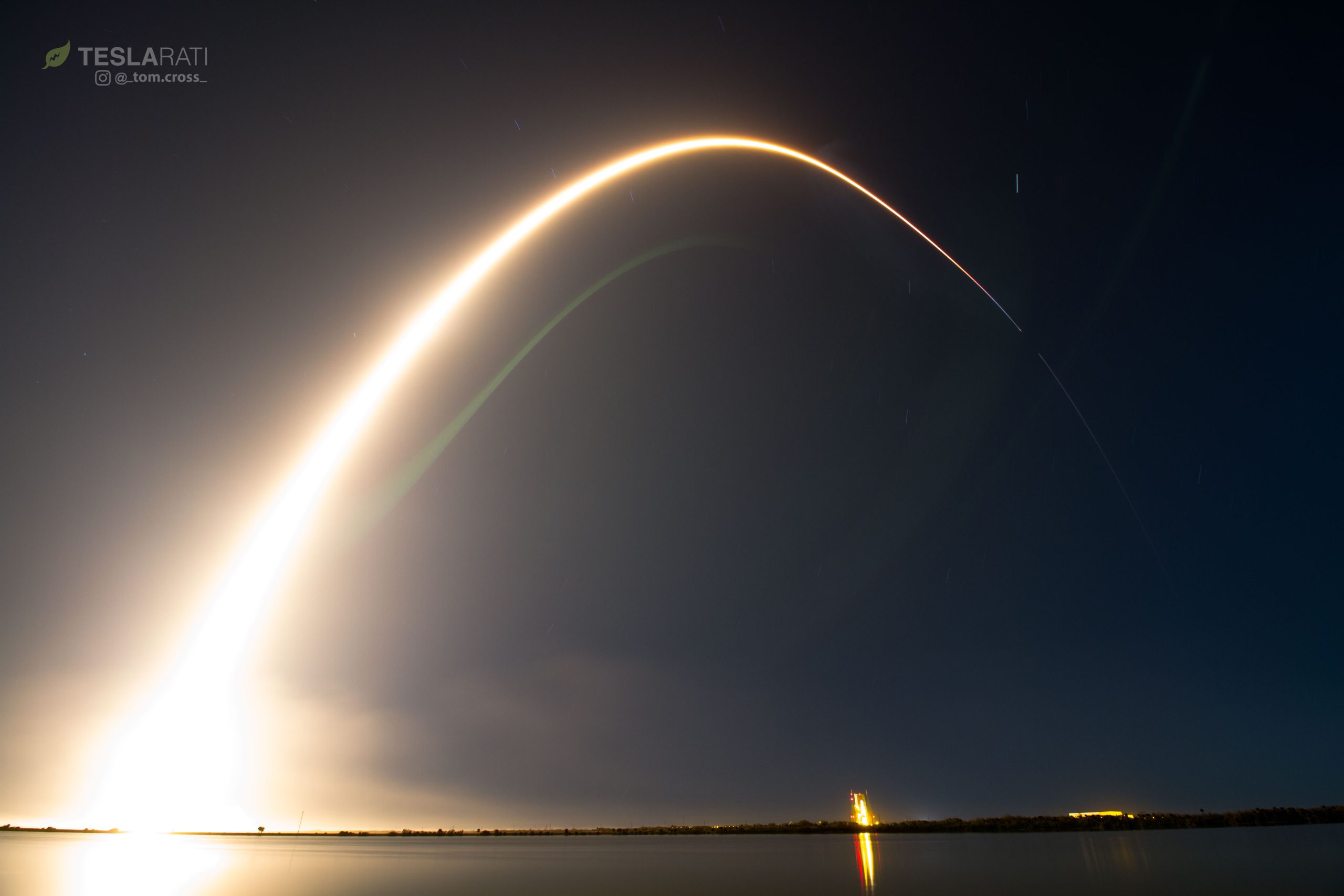
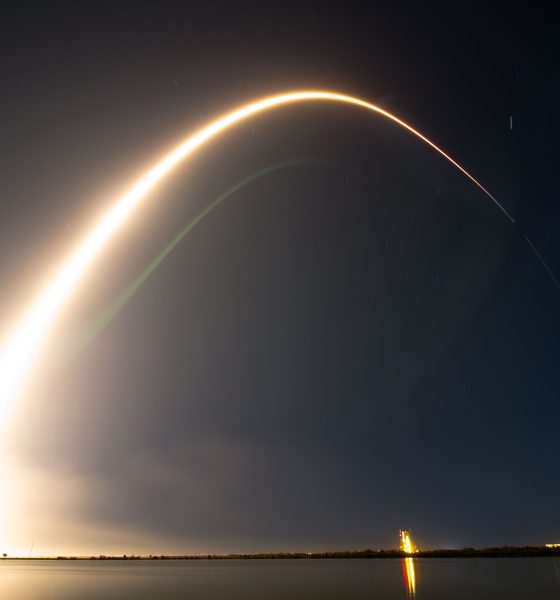
News
SpaceX tests extra-fast ocean landing, celebrates 50th launch
The happy tragedy of 1044
SpaceX has successfully completed the 50th launch of Falcon 9 a bit less than eight years after its 2010 debut, and has done so in a fashion that almost perfectly captures the veritable tsunamis the company has begun to make throughout the global aerospace industry. After a duo of delays due to hardware issues and range conflicts, this evening’s launch successfully placed Hispasat 30W-6 into a geostationary transfer orbit (GTO), where the massive ~6100 kilogram communications satellite will now spend several months raising its orbit to around 36,000 km (22,000 miles) above Earth’s surface.
Falcon 9 flight 50 launches tonight, carrying Hispasat for Spain. At 6 metric tons and almost the size of a city bus, it will be the largest geostationary satellite we’ve ever flown.
— Elon Musk (@elonmusk) March 5, 2018
Aside from becoming the heaviest commsat the company has yet to launch into GTO, the mission’s anticipated landing attempt stirred up quite a bit of intrigue and uncertainty in the spaceflight fan community. Stormy Atlantic seas, partially connected to the chaotic weather recently seen on the East coast, proved to be far too dangerous for SpaceX’s eastern recovery fleet and its drone ship, OCISLY, and they returned to Port Canaveral around 48 hours ago, under the watchful eyes of many anxious SpaceX followers. Tragically, this means that the brand new Falcon 9 booster (B1044) – originally expected to attempt perhaps the most difficult landing yet – had to be expended. Although the booster went through its paces as if it were preparing to land, it found no drone ship beneath it once it reached sea level, and subsequently dunked into the stormy Atlantic seas.
However, due to the last-minute nature of SpaceX and Hispasat’s decision to expend the booster rather than delay for better recovery conditions, launch technicians at Pad 40 simply did not have time to remove the rocket’s iconic landing legs and valuable titanium grid fins – the first time their titanium iteration has been chosen for a Falcon 9 to resist extreme reentry heating. Due to massive swells, recovery of even pieces of the expended booster – theoretically following a soft landing – will not be possible, as no SpaceX recovery vessels remained at the planned point of touchdown 400 miles off the Florida coast. Notably, following the successful inaugural flight of Falcon Heavy, CEO Elon Musk stated that upgraded titanium grid fins were “super expensive” and unequivocally “the most important thing to recover.” SpaceX’s decision to expend Falcon 9 B1044 without even sparing the time to remove the booster’s recovery hardware and titanium fins demonstrates just how focused the company is on its customers’ needs. In the case of geostationary communications satellites like Hispasat 30W-6, launch delays on the order of a few days can cause millions of dollars of financial harm to the parent company – each day a satellite spends on the ground orbit is also a day with no revenue generation, a less-than-thrilling proposition to shareholders.
- Falcon 9 1044 lifts off for its first and last time in a breathtaking display of power. (Tom Cross)
- Falcon 9 1044 vertical at Pad 40 around 72 hours before launch. (Tom Cross)
- Booster 1044 displays its number one last time. (Tom Cross)
- RIP B1044’s titanium grid fins. May they make a happy little reef at the bottom of the ocean. (Tom Cross)
B1044 sadly lost any hope at a second flight, but the data SpaceX gathered from its uniquely fast reentry and attempted soft-landing will hopefully pave the way for the recovery of Falcon 9 and Heavy boosters after all but the heaviest satellite launches. GovSat-1, a launch that saw its flight-proven booster famously survive a similarly hot landing in the ocean, was the first largely successful test of this new and experimental method of more efficiently recovering Falcons. By igniting three of its nine Merlin 1D engines instead of the usual single engine while landing, Falcon boosters can theoretically reduce the amount of fuel needed to safely land, fuel savings that can then be used to push its payloads higher and faster. However, the downsides of this approach are several. With three times as many engines igniting at landing, the margin of error for a successful landing becomes downright miniscule – the tiniest of problems with ignition, throttle control, or guidance could cause the rocket to smash into the drone ship at considerable speed. Additionally, triple the landing thrust would subject the booster to as much as 10Gs of acceleration (10 times the force of Earth’s gravity), forces that would almost instantaneously cause the average human (and even specially trained fighter pilots) to black out.
This rocket was meant to test very high retrothrust landing in water so it didn’t hurt the droneship, but amazingly it has survived. We will try to tow it back to shore. pic.twitter.com/hipmgdnq16
— Elon Musk (@elonmusk) January 31, 2018
Regardless of 1044’s untimely demise, another successful mission for SpaceX is purely positive. Happy customers make for a happy company, and SpaceX has achieved an incredible consistency of success in the last year alone. The loss of a new, potentially-reusable Falcon 9 booster is sad, but it only serves to foreshadow the imminent introduction of Falcon 9 Block 5, an upgrade hoped to realize Elon Musk’s decade-old dream of rockets that can be reused as many as 10 times with minimal refurbishment, and 100 times with maintenance. That debut could occur as early as April, just a month away.
https://twitter.com/_TomCross_/status/970900892005359617
Follow us for live updates, behind-the-scenes sneak peeks, and a sea of beautiful photos from our East and West coast photographers.
Teslarati – Instagram – Twitter
Tom Cross – Twitter
Pauline Acalin – Twitter
Eric Ralph – Twitter

News
Tesla FSD fleet is nearing 7 billion total miles, including 2.5 billion city miles
As can be seen on Tesla’s official FSD webpage, vehicles equipped with the system have now navigated over 6.99 billion miles.

Tesla’s Full Self-Driving (Supervised) fleet is closing in on almost 7 billion total miles driven, as per data posted by the company on its official FSD webpage.
These figures hint at the massive scale of data fueling Tesla’s rapid FSD improvements, which have been quite notable as of late.
FSD mileage milestones
As can be seen on Tesla’s official FSD webpage, vehicles equipped with the system have now navigated over 6.99 billion miles. Tesla owner and avid FSD tester Whole Mars Catalog also shared a screenshot indicating that from the nearly 7 billion miles traveled by the FSD fleet, more than 2.5 billion miles were driven inside cities.
City miles are particularly valuable for complex urban scenarios like unprotected turns, pedestrian interactions, and traffic lights. This is also the difference-maker for FSD, as only complex solutions, such as Waymo’s self-driving taxis, operate similarly on inner-city streets. And even then, incidents such as the San Francisco blackouts have proven challenging for sensor-rich vehicles like Waymos.
Tesla’s data edge
Tesla has a number of advantages in the autonomous vehicle sector, one of which is the size of its fleet and the number of vehicles training FSD on real-world roads. Tesla’s nearly 7 billion FSD miles then allow the company to roll out updates that make its vehicles behave like they are being driven by experienced drivers, even if they are operating on their own.
So notable are Tesla’s improvements to FSD that NVIDIA Director of Robotics Jim Fan, after experiencing FSD v14, noted that the system is the first AI that passes what he described as a “Physical Turing Test.”
“Despite knowing exactly how robot learning works, I still find it magical watching the steering wheel turn by itself. First it feels surreal, next it becomes routine. Then, like the smartphone, taking it away actively hurts. This is how humanity gets rewired and glued to god-like technologies,” Fan wrote in a post on X.
News
Tesla starts showing how FSD will change lives in Europe
Local officials tested the system on narrow country roads and were impressed by FSD’s smooth, human-like driving, with some calling the service a game-changer for everyday life in areas that are far from urban centers.

Tesla has launched Europe’s first public shuttle service using Full Self-Driving (Supervised) in the rural Eifelkreis Bitburg-Prüm region of Germany, demonstrating how the technology can restore independence and mobility for people who struggle with limited transport options.
Local officials tested the system on narrow country roads and were impressed by FSD’s smooth, human-like driving, with some calling the service a game-changer for everyday life in areas that are far from urban centers.
Officials see real impact on rural residents
Arzfeld Mayor Johannes Kuhl and District Administrator Andreas Kruppert personally tested the Tesla shuttle service. This allowed them to see just how well FSD navigated winding lanes and rural roads confidently. Kruppert said, “Autonomous driving sounds like science fiction to many, but we simply see here that it works totally well in rural regions too.” Kuhl, for his part, also noted that FSD “feels like a very experienced driver.”
The pilot complements the area’s “Citizen Bus” program, which provides on-demand rides for elderly residents who can no longer drive themselves. Tesla Europe shared a video of a demonstration of the service, highlighting how FSD gives people their freedom back, even in places where public transport is not as prevalent.
What the Ministry for Economic Affairs and Transport says
Rhineland-Palatinate’s Minister Daniela Schmitt supported the project, praising the collaboration that made this “first of its kind in Europe” possible. As per the ministry, the rural rollout for the service shows FSD’s potential beyond major cities, and it delivers tangible benefits like grocery runs, doctor visits, and social connections for isolated residents.
“Reliable and flexible mobility is especially vital in rural areas. With the launch of a shuttle service using self-driving vehicles (FSD supervised) by Tesla in the Eifelkreis Bitburg-Prüm, an innovative pilot project is now getting underway that complements local community bus services. It is the first project of its kind in Europe.
“The result is a real gain for rural mobility: greater accessibility, more flexibility and tangible benefits for everyday life. A strong signal for innovation, cooperation and future-oriented mobility beyond urban centers,” the ministry wrote in a LinkedIn post.
News
Tesla China quietly posts Robotaxi-related job listing
Tesla China is currently seeking a Low Voltage Electrical Engineer to work on circuit board design for the company’s autonomous vehicles.

Tesla has posted a new job listing in Shanghai explicitly tied to its Robotaxi program, fueling speculation that the company is preparing to launch its dedicated autonomous ride-hailing service in China.
As noted in the listing, Tesla China is currently seeking a Low Voltage Electrical Engineer to work on circuit board design for the company’s autonomous vehicles.
Robotaxi-specific role
The listing, which was shared on social media platform X by industry watcher @tslaming, suggested that Tesla China is looking to fill the role urgently. The job listing itself specifically mentions that the person hired for the role will be working on the Low Voltage Hardware team, which would design the circuit boards that would serve as the nervous system of the Robotaxi.
Key tasks for the role, as indicated in the job listing, include collaboration with PCB layout, firmware, mechanical, program management, and validation teams, among other responsibilities. The role is based in Shanghai.
China Robotaxi launch
China represents a massive potential market for robotaxis, with its dense urban centers and supportive policies in select cities. Tesla has limited permission to roll out FSD in the country, though despite this, its vehicles have been hailed as among the best in the market when it comes to autonomous features. So far, at least, it appears that China supports Tesla’s FSD and Robotaxi rollout.
This was hinted at in November, when Tesla brought the Cybercab to the 8th China International Import Expo (CIIE) in Shanghai, marking the first time that the autonomous two-seater was brought to the Asia-Pacific region. The vehicle, despite not having a release date in China, received a significant amount of interest among the event’s attendees.
